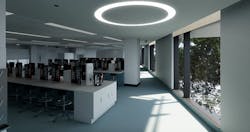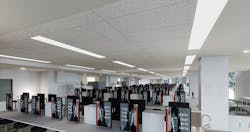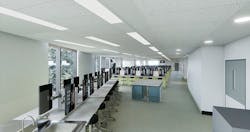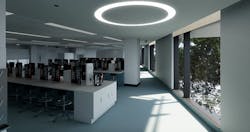Mass science: Superlab design best practices
Imagine dozens of brilliant scientists and scientists-to-be working side by side in one large, open and fully equipped lab space — a shared space humming with the activity of curious minds as they interact with, learn from and inspire one another. I would describe such a setting as nothing short of super. In fact, as many in the industry know, laboratory facilities that facilitate learning/teaching and the exchange of ideas in a large group environment, as well as potentially running multiple sessions in parallel, are often referred to as ‘superlabs’.
Established in 2006, the London Metropolitan University’s Science Centre is home to one such superlab. At 280 individual workstations, this superlab is not only considered one of the largest and most advanced educational science facilities in Europe, but is also often credited as being the first open-plan superlab in the world to enable scientific research and learning to be carried out simultaneously at such a scale.
HDR is currently working on a number of superlabs, which while not necessarily an entirely new concept, do constantly offer interesting opportunities to explore and compare teaching pedagogies. The value of such opportunities are reflected in the Australian university sector’s increasing interest in and demand for the benefits of the superlab.
So what is the major benefit that superlabs have to offer? Efficiency. A superlab provides greater efficiency due to its generally contiguous, albeit large, space — particularly when compared to traditional teaching laboratories comprised of multiple smaller spaces. Superlabs drive a theoretical efficiency on real estate and ‘teaching and support’ head count, both of which help maximize cost efficiencies in a very competitive university sector.
But while the flexibility of having larger numbers of students sharing a space at any given time may be economically appealing, it won’t count for much if the quality of teaching is adversely affected. As a former biologist myself, I can attest — based on my own days as an undergraduate in a biology practical — that a quality teaching process is key to knowledge retention and to making the journey of learning and discovery more enjoyable and exciting. I would also argue that the camaraderie developed between students is an equally valuable life skill for life beyond graduation.
The question, therefore, is this: What factors should design teams address to ensure high levels of teaching quality in superlabs? To answer that, I created a superlab design quality checklist to prompt some thoughts at the initial stage.
Technology
Technology is a critical challenge because technologies evolve at rates that are far faster than that of a large construction project, hence the importance of seeking qualified expertise and establishing suitable budgets. It is important to determine how students will use this space. We live in a ‘bring your own device’ era; tablet and hybrid devices are becoming increasingly common; and apps have become part of the teaching process. Design thinking has to accommodate for evolving patterns of use while considering the type of laboratory — from computer or engineering to, for instance, chemistry or microbiology. For example, bracket mounts cannot be an afterthought and have to be carefully planned out as part of the overall design of the space. The opportunity of running several lessons simultaneously in the same space can only work with the right technology in place and operational.
Acoustics
Noise is such a variable factor — the right amount of ‘good’ background noise can have a calming and comforting effect while stark silence can actually be quite confronting in a stressful environment. A ‘sound’ design (pun intended) considers the use of technology to address auditory quality that goes beyond volume control, for example through the use of directional speakers or more personal solutions such as headsets. Furthermore, when all is said and done, it is the architects’ and planners’ responsibility to ensure the spaces are compliant with all accreditation requirements and that the available materials and finishes have been utilized in the best manner possible.
Equipment
One of the biggest benefits of superlabs, again from an efficiency perspective, is the possibility of sharing equipment and making valuable inventory readily accessible. Secondary benefits related to equipment in a large, open laboratory environment include more efficient troubleshooting and improved repair and maintenance operations that can positively impact operational expenditures. A superlab environment provides staff with increased opportunities to monitor students and educate them on the use of equipment. In the case of microbiology, for instance, it is essential that students learn about the principles underlying a sterile workplace, equipment and technique, since cell culture experiments are ruined once contaminated.
Spatial Allowance
Safety in a laboratory setting is fundamental. Plenty of planning references and code requirements that influence lab planning and design address all issues from bench spacing to entrances and exits. Efficiency is by definition a key driver of superlab planning. That being said, a good layout will both maximize efficiency yet retain all aspects of sensible planning and rational layout of fixed items while allowing flexibility around loose items and equipment.
Spatial Allocation
One of the operational challenges facing superlabs is managing the tidal flow of student arrivals and departures — where the student population is of course far greater than in a traditional teaching laboratory. An integrated system that clearly articulates students’ bench locations, such as colored light indicators at workstations, is of the utmost importance, especially when several activities are being held simultaneously. Scheduling needs to be coordinated to provide seamless access to personal protective equipment and pick up/drop off lockers.
Environmental Quality and Quality of the Environment
Students deserve environments that encourage the exchange of ideas, promote a desire to learn, and that simply make them want to be there. Adequate lighting levels, air quality and thermal comfort are all basic requirements. A superlab environment should, however, aspire to improve on the limited palette and dreary backdrops typically associated with traditional laboratories. Just like other workplaces continuously evolve, so must laboratories. There are no excuses for a boring teaching environment.





